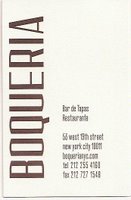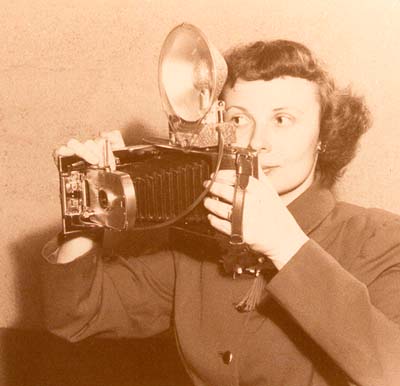 A funny thing happened when I sat down to write a review of Boqueria: Frank Bruni decided to do the same thing. It's never advisable to be behind the Times, especially when it comes to restaurant reviews. For one thing, I'll probably never be able to get a table at Boqueria again. Frank Bruni's review landed on the kitchen table on Wednesday morning, but I didn't look at it until I wrote this. I didn't want anything Count Frankula (of Bruni Digest fame) said to color my own memories of the place.
A funny thing happened when I sat down to write a review of Boqueria: Frank Bruni decided to do the same thing. It's never advisable to be behind the Times, especially when it comes to restaurant reviews. For one thing, I'll probably never be able to get a table at Boqueria again. Frank Bruni's review landed on the kitchen table on Wednesday morning, but I didn't look at it until I wrote this. I didn't want anything Count Frankula (of Bruni Digest fame) said to color my own memories of the place.
When my friend and I arrive at Boqueria, early, since they do not take reservations, we like the looks of the place. Beyond the lively bar area, the dining room manages to feel intimate and open at the same time, with a long, candlelit communal table running down the center, and banquettes with bar-height stools lining the sides. It's great for people-watching, and the chic crowd is easy on the eyes. Boqueria is also well-lit, which is a relief. Is eating in near-darkness a Spanish custom? I think it may be, from my own dim memories of holding up candles to plates of tapas in Barcelona and New York. Not being able to distinguish between a plate of dates and a plate of pickled peppers adds an unwanted element of excitement to the meal. Fortunately, there is no such mystery at Boqueria.
In the Times review, I see later that Bruni describes the space as "happy, peppy" and praises Boqueria for having "the virtues of stylishness without vanity." Agreed. He also mentions the bar-height seating, which "has a practical benefit, along with a theoretical one. It puts you at eye level with servers, making your interactions with them feel smoother and friendlier. And it means that if Manhattan somehow flooded, you could dine at Boqueria and keep your shoes dry." Wha? Bruni's flights of fancy can be vaguely terrifying. It's like that moment during a taxi ride when, at seventy miles per hour, you realize your driver is certifiably insane. The high stools aren't for floods. They're for checking out the "young, good-looking diners"! But the stool height does make it easier to talk to the servers - ours was quite knowledgeable and did not need to lean on a sommelier to recommend one of the great Spanish wines.
For the tapas, my friend gravitates towards the cojonudo, fried quail egg and chorizo on toast, on the grounds that everything is better with quail eggs. I love the taste of these, because I love anything that's bacon and eggs. "You don't need the toast," she says, chewing contemplatively. It's true: the dry toast detracts from the dish, sucking up all the flavor and not really contributing anything. But the chorizo-egg layer, which we pick up and eat on its own, is wonderfully smoky, spicy and creamy.
Bruni calls these "my kind of finger food." Bacon and eggs must be a sure crowd pleaser.
The pa de fetge, a boar terrine, has been recommended for anyone who likes country pate. It's very good, more pungent and flavorful than a plain pork terrine, and the caramelized onions served alongside are a great accompaniment. With the datiles con beacon y almendras, dates stuffed with almonds and cabrales and wrapped in bacon, each bite hits several extremes on the taste scale: the aching sweet of the dates, saltiness of the bacon, and the mouth-numbing blue of the cheese. The chef has taken standard cocktail party fare and turned it up several notches. It is intriguing and delicious.
Bruni doesn't mention the terrine, but he does recommend the salad with baby squid, the suckling pig, and the anchovies. Though he doesn't talk about dates, he comments on chef Seamus Mullen's "salty effects," but says he "wisely leavens his salty impulses with sweet ones." Agreed.
The lamb shank that comes as a main course is only OK, which is surprising because the prunes serves alongside are such a nice balance to the meaty flavor. "I wish some of this," my friend says, pointing to the prunes with her fork, "were on this. You don't even get the sense that they cooked it in wine." My friend, who is also a trained chef, adds that it's quite easy and surprisingly inexpensive to cook a lamb shank at home. I'll have to remember that if I ever return to lamb, meat trend of the moment.
Bruni thinks the lamb shank is "beautifully braised." Well, I suppose it's not ugly, but ours is not that great, not a unified dish. Disagree.
The sardine special turns out to be an experiment on a plate: sardines cooked two different ways, wrapped up and fried, or left in one shining fillet and laid across a potato. The latter, less experimental method tastes the best. I just had to try this after my memories of the butterfish escabeche at the Tasting Room.
Perhaps on crack, Bruni thinks the sardine special is "terrific." I do feel a twinge of envy, however, reading about his sardines. Where were the tons of olives and pine nuts in my fried sardine? Did they recognize Bruni and slip him some extra olives? Gyp.
The place is packed and noisy by now, and I've identified someone I know across the room - not surprising in this place. Still hungry, my friend and I continue plowing through the menu. She from a selection of cheeses - she is very knowledgeable on the matter, and so I space out as she orders and can't remember the cheese choices now. At any rate, they were good. The pinxto de jamon y melon, serrano ham and melon, arrives in kebob form: melon balls interspersed with salty folds of ham on a skewer. It's an unusual and pretty presentation that showcases the excellent quality of the ingredients. Brandada de hacalao, salt cod brandade, might be one of the oldest-school comfort foods there are, if you have read this book, Cod: A Biography of the Fish That Changed the World. My friend used to make brandade in culinary school, and explains that the salt cod must be mixed very carefully with mashed potatoes to get just the right flavor and consistency, which Boqueria accomplishes nicely.
By now we have racked up quite a tab, as per usual. As most of us who've felt the blow to our wallets have guessed, tapas has been one of the big culinary trends in recent years because it's a real money maker. There are even cooking school seminars that advocate chefs to cash in on the phenomenon. Despite this nagging sense of rip-off...
Here we reach the biggest difference between Bruni's take and mine: an expense account, or lack thereof. He waxes poetic about "the tapas spirit" which "took root here long ago, spreading wide and far" and allows one to "build meals incrementally." And check this Bruni humdinger: "The whole concept of grazing? It's just the tapas spirit wrapped in a gerund with reassuring connotations of restraint." Whoa, Nelly. I'll leave the ghosts of tapas past to the Bruni Digest - what a feast. But even the Gray Lady herself hinted that this whole "incremental plates" thing might be a price-fixing scheme, unwittingly initiated by the king of small plates, Tom Colicchio.
...I still find myself looking longingly at the plate of Pimi Entos Del Padron, blistered padron peppers with coarse sea salt, that arrives at the table next to ours. They look a lot like Nobu's excellent version. I'll have to save it for next time, though, if I can ever get a table at Boqueria again.
Thanks, Frank.
Boqueria: two stars.
 Boqueria
Boqueria53 West 19th Street, between Fifth and Sixth Avenues
212-255-4160


3 comments:
Mm, your descriptions sound lovely. Might I ask exactly how much did the tab blow your wallet? :)
I think it was $85-100 again. Mind you, we had a $45 bottle of wine though.
$85 and you didn't get any form of meatball? That's crazy talk there!
The problem with tapas beside the incredible cost is that you want a lot of people so you can order a lot of things, but more people = more sharing and more sharing = more pretending to be polite and patient as the person next to you takes the last bacon and egg delight. Why can't tapas be priced like dim sum?
Post a Comment